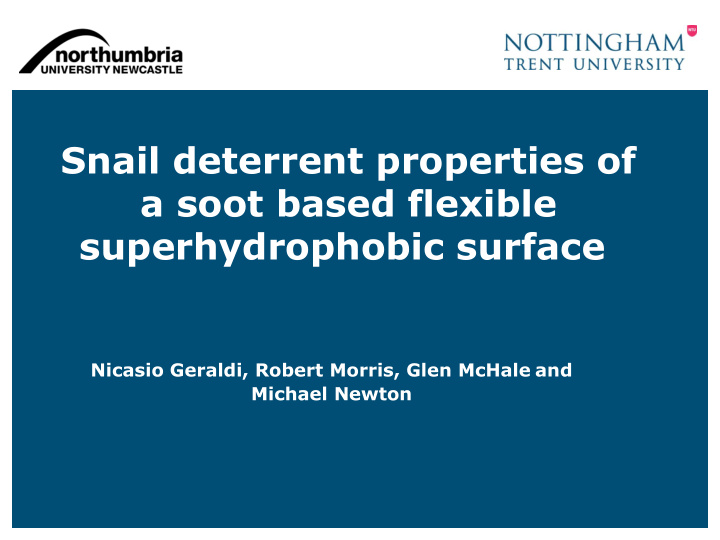



Snail deterrent properties of a soot based flexible superhydrophobic surface Nicasio Geraldi, Robert Morris, Glen McHale and Michael Newton
Introduction • Snails enjoying eating the leaves of many garden plants including food crops. • Deterring this pest without resorting to chemicals can present a significant challenge • In a previous report by Shirtcliffe et al * the possibility of superhydrophobic surfaces acting as a deterrent to snails was investigated • They put forwards the hypothesis that an effective anti-adhesive snail resistant superhydrophobic surface is one that can maintain a high receding contact angle even when challenged by an anionic surfactant. • In this work we investigate if a soot based superhydrophobic surface is a good candidate for this task. *Shirtcliffe, N.J.; McHale, G.; Newton, M.I. Wet Adhesion and Adhesive Locomotion of Snails on Anti-Adhesive Non-Wetting Surfaces PLOS ONE 2012, 7, e36983
Superhydrophobicity • A superhydrophobic surface is characterised by a high water contact angle (>150 o ) and low contact angle hysteresis. • This is the result of hydrophobic chemistry and surface roughness. • The roughness can be from tens of nm to tens of microns in scale. • In this work we use a soot layer to provide both the surface roughness and the hydrophobic chemistry.
Making a soot/PDMS superhydrophobic surface * • Rapeseed oil was left burning several minutes, using a wick, until a stable flame developed. • Copper sheets were coated with a thick layer of matt black rapeseed oil soot. • PDMS was mixed in a 10:1 ratio, degassed in a vacuum desiccator, spread onto acrylic slides at 1mm thickness and prebaked for 30-35 minutes at 80°C until the PDMS became tacky. • The soot coated slides were gently positioned, soot side down, onto the PDMS and returned to an oven at 60°C for at least an hour. • After cooling the acrylic s and copper sheets were removed leaving a PDMS membrane with a soot nanoparticle coating * Geraldi, N.R.; Ouali, F .F .; Morris, R.H.; McHale, G.; Newton, M.I. Capillary origami and superhydrophobic membrane surfaces. Applied Physics Letters 2013, 102, 214104
Water drops on soot/PDMS
Simple tests of snail repellency • A zigzag track was produced on an acrylic sheet using sections of the soot/PDMS to mark the boarders. • Young snails, helix aspersa, were placed at the bottom of the vertically mounted track with snail food at the top and filmed with a video camera. • The picture shows time lapse images of a snail following the track to the food
Simple tests of snail repellency • Two pots were prepared, one polypropylene and one polypropylene with a PDMS/soot coating • Both pots had fresh snail food on the top. • 24 hours after snails were admitted to the enclosure, only the food on the polypropylene had been eaten. • After 48 hours only one snail had managed to climb the PDMS/soot coated pot
Spin testing • A snail centrifuge was constructed using a modified spin coated with a dc power supply used to power the motor and a tachometer used to measure the speed. • A snail was placed 50mm from the centre and the speed slowly increased until the snail was removed and this was used to calculate to force. • This process was repeated for several snails on each of the different surfaces tested. To allow the centrifuge data to be converted into force per unit footprint area, the foot print of snails were measured as a function of their mass. • Loose soot on glass requires the least force to remove the snails with soot/PDMS requiring a slightly greater force but significantly less than PDMS, acrylic, polypropylene or glass.
Footprint area as a function of body mass.
Centrifuge data for different surfaces
Receding contact angles • One hypothesis by Shirtcliffe et al * for the effectiveness of snails to adhere to and traverse a wide range of surfaces was that the mucus included a weak bio surfactant that was able to reduce the receding contact angle and create high contact angle hysteresis. • The implication of this hypothesis is that a snail resistant superhydrophobic surface should be one that is able to maintain a high receding contact angle even when challenged by an appropriate surfactant. • In the next slide we show the receding contact angles for different solutions of the anionic surfactant sodium dodecyl sulfate (SDS). • PDMS/soot is shown as black triangles, PDMS is red squares, polypropylene is blue triangles, Acrylic is purple diamonds), glass is green circles and HIREC data from Shirtcliffe et al * is green triangles. *Shirtcliffe, N.J.; McHale, G.; Newton, M.I. Wet Adhesion and Adhesive Locomotion of Snails on Anti-Adhesive Non-Wetting Surfaces PLOS ONE 2012, 7, e36983
Receding contact angles for different solutions of SDS
Conclusion • Soot/PDMS has been shown to require little force to remove a snail from its surface. • In surfactant testing the best of the materials tested by Shirtcliffe et al * was the HIREC which had a transition from high to low receding contact angle for surface tension between 65 mN/m and 70 mN/m. • The soot/PDMS exceeds this significantly by retaining a high receding contact angle down to surface tensions of between 40 mN/m and 50 mN/m. • This supports the hypothesis that an effective anti-adhesive snail resistant superhydrophobic surface is one that can maintain a high receding contact angle when challenged by an anionic surfactant, such as SDS. *Shirtcliffe, N.J.; McHale, G.; Newton, M.I. Wet Adhesion and Adhesive Locomotion of Snails on Anti-Adhesive Non-Wetting Surfaces PLOS ONE 2012, 7, e36983
Recommend
More recommend